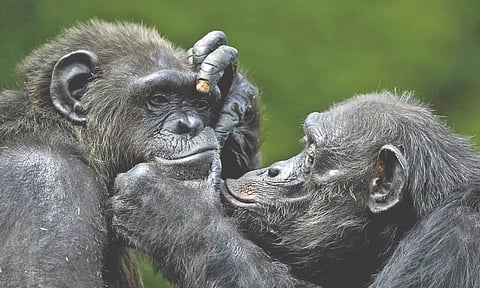

NEW YORK: In 2015, while working as an undergraduate researcher at the North Carolina Zoo, Laura Lewis became friends with a male chimpanzee named Kendall. Whenever she visited the chimps, Kendall would gently take her hands and inspect her fingernails. Then she disappeared for the summer to study baboons in Africa. When she returned to North Carolina, she wondered if Kendall would still remember her face. Sure enough, as soon as she stepped into his enclosure, Kendall raced up and gestured to look at her hands.
“The feeling I got was that he clearly remembered me after four months away,” said Dr. Lewis, now a comparative psychologist at the University of California, Berkeley.
“But I didn’t have the data to prove it.” Now she believes that she does. In a study published on Monday, Dr. Lewis and her colleagues have demonstrated that chimpanzees and bonobos can recall faces of other apes that they have not seen for years. One bonobo recognized a face after 26 years — a record for facial memory beyond our species.
Dr. Lewis and her colleagues carried out the study on 26 apes kept at the Edinburgh Zoo in Scotland, the Kumamoto Sanctuary in Japan and the Planckendael Zoo in Belgium.
At each facility, the researchers rolled up a computer to the apes’ enclosure fence and displayed images of animals on the monitor. A straw attached to the fence allowed the apes to drink juice as they gazed at the photos.
After giving the apes a few months to acclimate to the unusual setup, Dr. Lewis and her colleagues began their experiment. As the animals sipped their juice, the computer displayed pairs of ape faces for three seconds at a time. In every pair, one of the faces was a stranger and the other an old companion whom the ape had not seen for years.
The scientists used an infrared camera to film the animals’ eye movements. If the apes had no memory of their old companions, the scientists expected them to spend equal time glancing at both pictures. But that’s not what the researchers found. The apes consistently spent more time looking at their former companions. (Kinship played no part in the results, as unrelated past acquaintances also got more attention than strangers did.)
A 46-year-old bonobo named Louise at the Kumamoto Sanctuary demonstrated the oldest memories. Until 1992, she lived at the San Diego Zoo with her sister and her nephew. Then she moved to the Cincinnati Zoo before coming to the Kumamoto Sanctuary in 2014. In 2019, Dr. Lewis and her colleagues found that Louise gazed longer at her long-lost relatives’ faces than at those of apes she had never met, even after being separated for over 26 years. Dr. Lewis cautioned that tracking eye movements only gives a limited glimpse inside the minds of the apes. “We can’t fully characterize what their memories look like,” she said.
But the researchers did find one tantalizing clue suggesting that fond memories might remain strong over the years. The apes spent a little more time looking at the faces of animals they once had positive experiences with, according to ratings submitted by zoo caretakers.
Dr. Lewis speculates that apes might benefit from these durable memories. A female bonobo, for example, will typically leave her mother’s group to join another group for the rest of her life. If the two groups encounter one another years later, she may be able to form an alliance with old acquaintances.